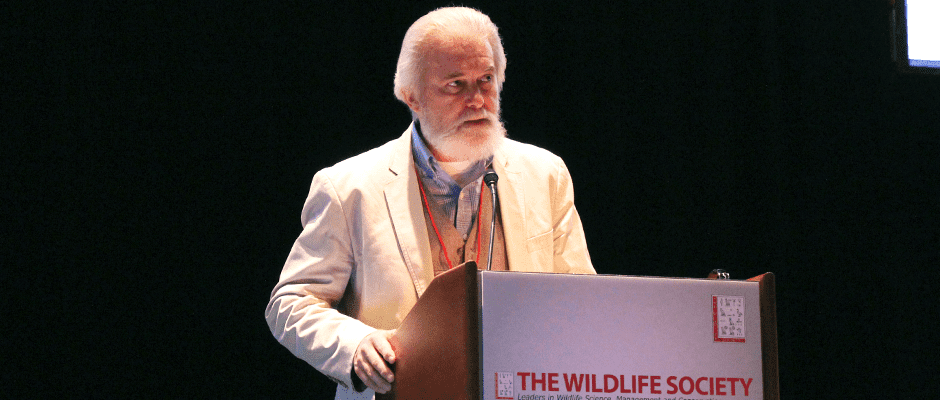Share this article
Opening plenary calls on wildlife professionals to forge collaborations
The Wildlife Society’s Annual Conference in Raleigh, North Carolina, kicked off Sunday morning with a plenary symposium on the future of conservation through partnerships. TWS President Gary Potts has made expanding partnerships the theme of his presidency. In his opening remarks, he explained how TWS went from just handful of partnerships a few years ago to around 30 today.
Shane Mahoney, president and CEO of Conservation Visions Inc., took the stage to deliver a ringing call to action. During his career, Mahoney has studied and managed wildlife, led the establishment of TWS’ Canadian Section, advised groups such as the International Union for Conservation of Nature, and created multimedia stories, narrating films with his powerful voice. That same voice drew every ear in the hushed and crowded auditorium.
“Our profession now — this profession of conservation, right now — is more important than it has ever been,” he said. “There is not a species that lives upon this planet today whose future is not determined by the decisions we make, the decisions we defer, or the decisions we avoid.”
Mahoney drove home the point that successful conservation requires cooperation between diverse groups of people. Many animals roam between states, countries, and even continents. Partnerships have been crucial for past conservation successes, from the “Y2Y” initiative that protects habitat from Yellowstone to the Yukon, to whaling policies that protect Earth’s largest animals.
“Do we think the great whale resurgence that has occurred for species like humpbacks and so on around the globe was possible without partnerships? That someone simply sat in their office as a cetacean scientist and said ‘let there be whales’?” Mahoney asked the assembled wildlife managers, biologists and students.
John Beck took the stage next to share his practical expertise on building and maintaining effective partnerships. Beck is an associate professor in the School of Human Resources & Labor Relations at Michigan State University, and he has worked extensively with wildlife organizations at the Michigan Department of Natural Resources and Michigan State University.
Beck drew a distinction between two kinds of partnerships: transactional and transformational. In transactional partnerships, partner organizations act like tools in a tool belt.
“We collect the various tools, we put them together for this specific task, and then at the end of that, we’re able put them back on the pegboard,” he said. “The tools themselves very well may be unchanged.”
In contrast, the partners in a transformational partnership are more like grapes in a fine wine. “When one’s fused, the fruit becomes something even greater that cannot return to individual grapes,” he explained.
To maximize progress toward conservation goals, Beck encouraged the audience to strive for these more ambitious partnerships. At the same time, he said, each organization must start with its own vision.
“You have to be sure who you are and the motivations that you bring to the work,” he said. “Setting out that ‘true North’ is truly essential, since you may ultimately go all over the map before you get to the destination.”
In line with his partnership theme, Potts offered thanks and recognition to Strategic partners before the session started: Bill Clay from USDA’s Wildlife Services, Cindy Jacobson from the U.S. Fish and Wildlife Service, and Becky Langer-Curry from Bayer Bee Care, which sponsored the plenary event.
Potts also presented two awards for important contributions to the wildlife profession. The Caesar Kleberg Award for Excellence in Applied Wildlife Research went to Terry Messmer from Utah State University, and the Jay N. “Ding” Darling Memorial Award for Wildlife Stewardship Through Art went to artist Maynard Reece.








